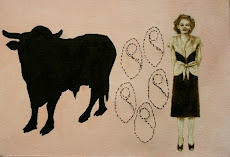I
A Brief Monologue Wherein Our Hero, a Formerly Comatose and Wrongfully Accused Young Patient, Makes Good his Escape from Sayreville County Hospital, Displaying at Once Resourceful Cunning and Multiple Behavioral Symptoms of Having Sustained a Massive Head Injury
Greetings, Mr. Worthington! How are you feeling today? Good? I hope the answer is “good.” My name is Samuel Curtis and as you’ve probably guessed from my stethoscope and wristwatch I am a real doctor gainfully employed at this hospital. I will be attending to your case this afternoon. Please disrobe and lay face-down on the table while I look in this cupboard for a medical chart (i). Help yourself to a paper dress. The lollipops are delicious.
The area right here resembling exposed skull is, as you will notice on further inspection, nothing but plaster bandages carefully shaped and painted. Go ahead and touch it, Mr. Worthington. Doesn’t it feel real? Doesn’t it feel like genuine exposed skull, throbbing below your fingertips? Please do not be disgusted. Nothing you’re experiencing is real. Those secretions you’re encountering are also synthetic.
And what about the fissure? At the center of the plaster, can you distinguish a long crack? A narrow little cavity? A hole that extends straight down to the interior? If you hazard a second look you will no doubt catch just the faintest glimpse of grayish pink brain, nestled below the surface. It is nothing but smoke and mirrors, Mr. Worthington! A little black paint for the illusion of depth; a little pink polish for the temporal lobe, and voila— a thoroughly convincing cranial fracture! Go ahead and get a pinky in there… that’s right, keep going… keep going… okay, that’s far enough.
Now, Mr. Worthington, have I thoroughly calmed your fears? Are your uncertainties abated? Your questions answered? Your prejudices quelled? As you can tell I am a man of science— abreast in every way of the latest techniques. My approach may be unorthodox, my demeanor may be odd, and I may smell unpleasantly of uncured ham— but I am nevertheless your doctor. And after everything I’ve shown you I hope you’re ready to trust me. I hope that you’re ready to begin the examination and move forward in our friendship. Are you, Mr. Worthington? Are you ready to trust again? Are you ready at last to let yourself be vulnerable?
Mr. Worthington, I have with me a sedative to dispel whatever lingering feelings of anxiety you may possess. I normally wouldn’t insist but— given your initial wariness— this may be the only way for us to secure accurate data. If you trust me as your doctor and have faith in my techniques, I will administer this needle before continuing your examination. If not, I will leave you in peace to locate another practitioner. The decision is yours.
So, what will it be, Mr. Worthington? Will you take the sedative? Have you decided to take my advice? Have you decided to trust me?
(i) An excerpt from Mr. Worthington’s medical chart, located several days later by police investigators:
Patrick Worthington
DOB: 10/11/1959
03/14/2016
PHYSICIAN: Samuel “Wallaby” Curtis
PHYSICAL EXAMINATION:
VITALS: Still vital.
SKIN: White.
Head, Eyes, Ears, Nose, and Throat: One of each. Except for the ears. And the eyes. And the… nostrils?
CHEST: Present.
CARDIAC: Super.
BREASTS: In the A range, I suppose.
RECTOVAGINAL: Definitely recto.
UTERINE: This may be the wrong chart.
MENSTRUAL: This is almost definitely the wrong chart.
LABIAL: Where do we keep the other charts? Is there a cabinet for men? By which I don’t mean a cabinet filled with tiny little men, but rather a cabinet filled medical charts designed for regular sized men, with regular sized ailments. And where would we keep such a cabinet, if we had one?
EXTREMITIES: Good.
NEUROLOGIC: Very good.
NODES: Very, very good.
SPINAL: Very, very, very good…
*
Nick McArthur's first book, Short Accounts of Tragic Occurances, was published by DC Books last year. You'll want to read it.


No comments:
Post a Comment